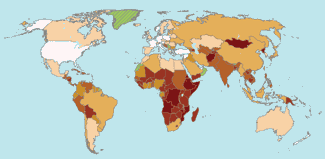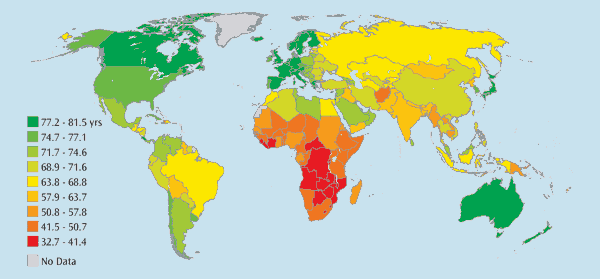“Big” is a value in America, and this includes food. I’ve long suspected that portions were generally larger in the United States than the rest of the world, and a quick check shows this to be actually true. This map from theglobaleducationproject.org shows that Americans (and Western Europeans) really do consume substantially more calories than everyone else in the world.

No big surprise here — the the citizens of richer countries do eat more food. The interesting thing is to ask what the actual numbers mean, in terms of health. Simply put, people living in the developed world eat way too much. Oddly, this might mean that the current poor will one day be healthier than the formerly rich.
On this map, white means 3400-3700 calories per person per day. The US Health and Human Services Dietary Guidelines 2005 includes a rather sophisticated chart recommending average daily caloric intake for men and women of different ages and levels of activity, but the maximum value on it is 2800-3200 calories/day for a teenage male who walks more than three miles per day. By comparison, the average sedentary 35 year old woman needs just 1800 calories per day. This means that many people in America must actually be eating twice as much as they need.
There are epidemic health problems with this, obesity and its consequences (heart disease, diabetes) being the most obvious. But there is a less well-known advantage to eating less: it might make you live longer. In 1935 it was discovered that rats kept on a very restricted diet lived 30% longer, four years instead of the usual three. Since then it has been established that that “calorie restricted” diets increase lifespan in mice, dogs, and, in the last few years monkeys. There is still no direct evidence that eating less will make a human live longer — that will take decades — but the early results of small, short term studies are highly suggestive that it will.
And yet all those underfed people in Africa are dying sooner than well-fed whites, as this map of global lifespan shows.

Contrary to research, you can see that global lifespan is more or less highly correlated with caloric intake. Why is this? One longevity researcher notes that “In experiments of nature, humans have been subjected to periods of nonvolitional partial starvation. However, the diets in almost all of these cases have been of poor quality.” In other words, there is a difference between eating less and starving; besides which, we rich people have access to all the wonders not only of modern medicine but of simple public health infrastructure, such as clean water.
Still, it’s not hard to imagine that one day, Africans etc. will be able to eat “high quality” diets and drink clean water. What then? Perhaps the formerly poor of the world will follow us into gluttony just because they can. Or, perhaps their frugal eating habits will persist, raising the strange possibility that the citizens of the developing world will actually begin to outlive us.
But I doubt it. While data from India over the last several decades actually show slight decline in overall per-capita caloric intake, the richest 30% of the population is definitely eating more. Like people, nations usually have to make all their own mistakes before they learn.
Just do me a favor and keep writing such trnchnaet analyses, OK?